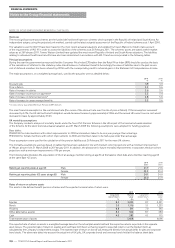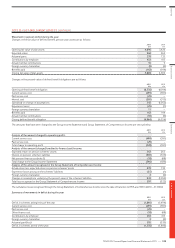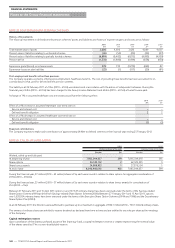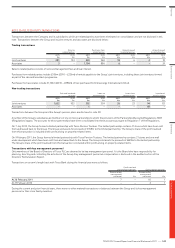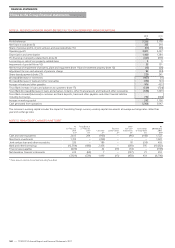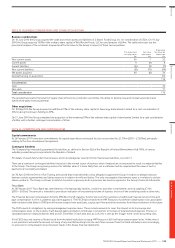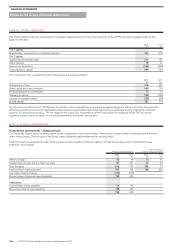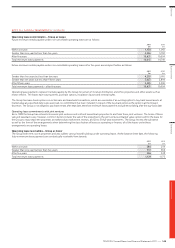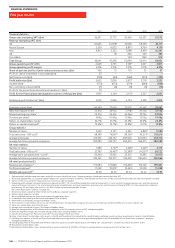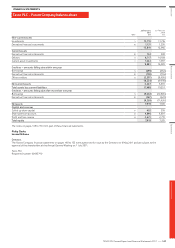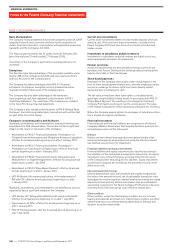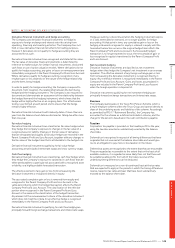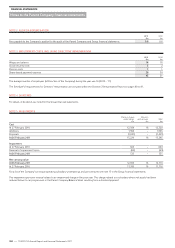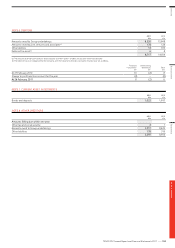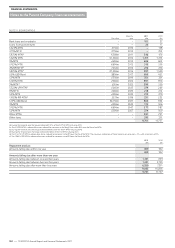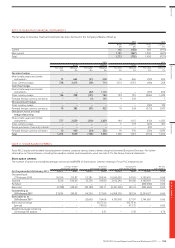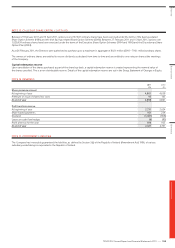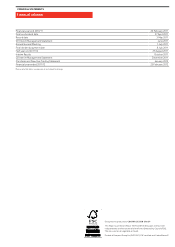Tesco 2011 Annual Report Download - page 152
Download and view the complete annual report
Please find page 152 of the 2011 Tesco annual report below. You can navigate through the pages in the report by either clicking on the pages listed below, or by using the keyword search tool below to find specific information within the annual report.
Basis of preparation
The Company financial statements have been prepared under UK GAAP
using the historical cost convention modified for the revaluation of
certain financial instruments, in accordance with applicable accounting
standards and the Companies Act 2006.
The financial year represents the 52 weeks ended 26 February 2011
(prior financial year 52 weeks ended 27 February 2010).
A summary of the Company’s significant accounting policies is set
out below.
Exemptions
The Directors have taken advantage of the exemption available under
Section 408 of the Companies Act 2006 and not presented a Profit
and Loss Account for the Company alone.
The Company has taken advantage of the FRS 29 ‘Financial
Instruments: Disclosures’ exemption and not provided derivative
financial instrument disclosures of the Company alone.
The Company has also taken advantage of the exemption
from preparing a cash flow statement under the terms of FRS 1
‘Cash Flow Statement’. The cash flows of the Company are included
in the Tesco PLC Group financial statements.
The Company is also exempt under the terms of FRS 8 ‘Related Party
Disclosure’ from disclosing related party transactions with entities that
are part of the Tesco PLC Group.
Changes in accounting policy and disclosure
Standards, amendments and interpretations adopted, following new
amendments to FRS interpretations. These have not had a significant
impact on the results or net assets of the Company:
• Amendment to FRS 25 ‘Financial Instruments: Presentation’ on
‘Puttable Financial Instruments and Obligations Arising on Liquidation’,
effective for annual periods beginning on or after 1 January 2010.
• Amendment to FRS 25 ‘Financial Instruments: Presentation’ –
Presentation on Classification of Rights Issues, effective for annual
periods beginning on or after 1 February 2010.
• Amendment to FRS 26 ‘Financial Instruments: Recognition and
Measurement’ on Eligible Hedged Items, effective for annual periods
beginning on or after 1 July 2009.
• Amendment to FRS 20 ‘Share Based Payment’, effective for annual
periods beginning on or after 1 January 2010.
• UITF 48 Abstract ‘Accounting implications of the replacement of
RPI with CPI’, effective for annual periods beginning on or after
1 January 2010.
Standards, amendments and interpretations not yet effective, but not
expected to have a significant impact on the Company:
• UITF Abstract 47 ‘Extinguishing liabilities with equity instruments’,
effective for annual periods beginning on or after 1 July 2010.
• Improvements to FRSs, effective for annual periods beginning on or
after 1 January 2011.
• FRS 30 ‘Heritage Assets’, effective for annual periods beginning on or
after 1 April 2010.
Current asset investments
Current asset investments relate to money market deposits which are
stated at cost. All income from these investments is included in the
Parent Company Profit and Loss Account as interest receivable and
similar income.
Investments in subsidiaries and joint ventures
Investments in subsidiaries and joint ventures are stated at cost less,
where appropriate, provisions for impairment.
Foreign currencies
Assets and liabilities that are denominated in foreign currencies are
translated into Pounds Sterling at the exchange rates prevailing at the
balance sheet date of the financial year.
Share-based payments
Employees of the Company receive part of their remuneration in the
form of share-based payment transactions, whereby employees render
services in exchange for shares, rights over shares (equity-settled
transactions) or in exchange for cash.
The fair value of employee share option plans is calculated at the
grant date using the Black-Scholes model. In accordance with FRS 20
‘Share-Based Payment’ the resulting cost is charged to the Parent
Company Profit and Loss Account over the vesting period. The value
of the charge is adjusted to reflect expected and actual levels of vesting.
Where the Company awards options to employees of subsidiary entities,
this is treated as a capital contribution.
Financial instruments
Financial assets and financial liabilities are recognised on the Parent
Company’s Balance Sheet when the Company becomes a party to the
contractual provisions of the instrument.
Debtors
Debtors are non interest-bearing and are recognised initially at fair
value and subsequently at amortised cost using the effective interest
rate method, less provision for impairment.
Financial liabilities and equity instruments
Financial liabilities and equity instruments are classified according to
the substance of the contractual arrangements entered into. An equity
instrument is any contract that gives a residual interest in the assets
of the Company after deducting all of its liabilities. Equity instruments
issued by the Company are recorded as the proceeds received, net of
direct issue costs.
Interest-bearing borrowings
Interest-bearing bank loans and overdrafts are initially recognised at
the value of the amount received, net of attributable transaction costs.
Subsequent to initial recognition, interest-bearing borrowings are stated
at amortised cost with any differences between cost and redemption
value being recognised in the Parent Company Profit and Loss Account
over the period of the borrowings on an effective interest basis.
Other creditors
Other creditors, except for intercompany creditors, are non interest-
bearing and stated at amortised cost. Intercompany creditors are either
interest-bearing or non interest-bearing depending on the type and
duration of creditor relationship.
NOTE 1 ACCOUNTING POLICIES
FINANCIAL STATEMENTS
148
—
TESCO PLC Annual Report and Financial Statements 2011
Notes to the Parent Company financial statements


